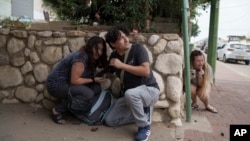The fighting between Israelis and Hamas militants is the latest clash in a conflict that some people believe dates back to events described in the Bible.
Over the weekend, Hamas launched a surprise attack in Israel from the Palestinian territory of Gaza. Hamas gunmen killed more than 1,200 people, including women and children. The group also took more than 150 people as hostages.
Israel answered with airstrikes of what it said were Hamas targets in Gaza. Officials in the Palestinian-controlled area said more than 1,000 have been killed, including some children. Thousands have also been wounded on both sides.
What started the conflict?
The modern conflict between Israelis and Palestinians is mainly a territorial dispute in Palestine, an area now known as Israel, the Gaza Strip, and the West Bank. Parts of the land are also considered the holiest places to Jews, Christians and Muslims.
The Roman Empire controlled the area at the time Jesus was believed to have been born in Bethlehem. Following the death of Rome’s ally, King Herod, the land was divided into five locally administered areas under Rome.
Later, the land then came under the Ottoman Empire's control for about 400 years until the end of World War I. After World War I, Britain controlled the area it called Palestine and expressed support for “the establishment in Palestine of a national home for the Jewish people.”
In November 1947, the United Nations General Assembly passed a resolution dividing the British-ruled area of Palestine into two states, one Jewish and one Arab, with Jerusalem under a UN administration. On May 14, 1948, the modern State of Israel was established for Jews fleeing persecution and seeking a homeland.
Arab countries rejected the UN plan, arguing that it was unfair and violated the UN Charter. In the war that followed, some 700,000 Palestinians, half the Arab population in Palestine, fled or were driven from their homes. They ended up in Jordan, Lebanon, and Syria as well as in Gaza, the West Bank, and East Jerusalem.
Israel denied that it sought to drive Palestinians from their homes. The new country said it was attacked by five Arab states the day after its creation. Armistice agreements halted the fighting in 1949, but there was no official peace treaty.
Palestinians call the creation of Israel the “Nakba” in Arabic. It means a disaster, or catastrophe, that resulted in mass displacement and blocked their dreams of statehood.
Other major wars
In 1967, Israel launched the Six-Day War against Egypt and Syria. Israel has occupied the West Bank, Arab East Jerusalem, which it captured from Jordan, and Syria's Golan Heights ever since.
In 1973, Egypt and Syria attacked Israeli positions along the Suez Canal and Golan Heights, beginning the Yom Kippur War. Israel pushed both armies back within three weeks.
Israel invaded Lebanon in 1982 aiming to remove Palestinian Liberation Organization (PLO) fighters under Yasser Arafat. In 2006, war erupted in Lebanon again when Hezbollah militants captured two Israeli soldiers and Israel retaliated.
What is Hamas?
In 1987, Sheikh Ahmed Yassin, a Palestinian refugee living in Gaza, during the first intifada, or uprising, founded Hamas. The name in Arabic means the Islamic Resistance Movement.
The group does not recognize Israel's right to exist. It has launched many deadly attacks, including suicide bombings against Israelis. In 1997, the U.S. State Department named Hamas a terrorist organization. So has the European Union and other Western countries.
In 2005, Israel withdrew from the Gaza Strip, which it had captured in 1967. Hamas won the 2006 parliamentary elections over the Palestinian Authority and took control of Gaza. The Palestinian Authority still administers the semi-autonomous, or partly self-ruling, areas of the Israeli-occupied West Bank.
Israel answered the Hamas takeover with a blockade on Gaza. It restricted the movement of people and goods to keep the group from developing weapons. Over the years, Hamas received support from many Arab countries. Recently, it has moved closer to Iran and its allies.
Current issues
For over 40 years, efforts have aimed to bring peace to the area.
In 1979, Egypt and Israel signed a peace treaty. Israeli Prime Minister Yitzhak Rabin and PLO chief Arafat agreed in 1993 to set up Palestinian autonomy in the West Bank and the Gaza Strip. The following year, Israel signed a peace treaty with Jordan.
In 2002, an Arab plan offered Israel normal ties with all Arab countries in return for a full withdrawal from the lands it took in the 1967 Middle East war, the creation of a Palestinian state, and a "just solution" for Palestinian refugees.
The two sides, however, are far apart on most issues.
Hamas has rejected the two-state solution. It has sworn to destroy Israel. Israel has increasingly built new Jewish settlements on occupied land over Palestinian objections.
Palestinians want East Jerusalem to be the capital of the Palestinian state. East Jerusalem has areas that are holy to Muslims, Jews, and Christians. But Israel has established “indivisible” Jerusalem as the country’s capital.
Today about 5.6 million Palestinian refugees still live in Jordan, Lebanon, Syria, the Israeli-occupied West Bank and Gaza. Palestinians have long demanded that refugees should be permitted to return home. But Israel says any resettlement of Palestinian refugees must take place outside of its borders.
I’m Anna Matteo.
And I'm Dan Novak.
Hai Do wrote this report for VOA Learning English from VOA, Associated Press, Reuters, and the United Nations sources.
_________________________________________________
Words in This Story
armistice –n. a truce; and agreement to stop fight
blockade –n. when a country uses force to block trade, supplies or people from entering another country
autonomy –v. the right of a country to rule itself
We want to hear from you.
Our comment policy is here.

















Forum